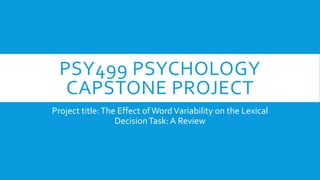
Effect of Word Variability on Lexical Decision Task
- 1. PSY499 PSYCHOLOGY CAPSTONE PROJECT Project title:The Effect ofWordVariability on the Lexical DecisionTask: A Review
- 2. SCOPE Introduction Literature review Research objective & hypothesis Method Results Discussion & conclusion Q&A
- 3. LET’S DO A SIMPLE QUIZ! Is this a word? ZARF
- 5. ZARF = SLEEVE Zarf /zarf/ [n]: a small, metal holder, used in the Levant to hold a cup of hot coffee. (Collins American English Dictionary) A very valuable word in Scrabble ;)
- 6. INTRODUCTION Azarbehi, Piercey and Joordens (2011):The effect of WordVariability on the Lexical DecisionTask Word feature variability: Degree of spread of word feature in a presentation list Features manipulated Word frequency Orthographic neighbourhood Finding Interaction effect (word list type: words , non-words x stimulus type: homogenous, heterogenous) Critiques 1. Small, uniformed sample 2. Possible confounding variables (word frequency and orthographic neighbourhood)
- 7. LITERATURE REVIEW Critique 1 : Small, uniformed sample Depth of writing script could influence performance on language tasks - > language background of participant needs to be accounted for. (Liow & Poon, 1998) Interference effects might account for variance in Lexical Decision (Ehrich & Meuter, 2009) Critique 2: Possible confounding variables (word frequency and orthographic neighbourhood) Some studies attempted to hold other word features constant (Connine, Mullennix, Shernoff, &Yelen, 1990; Niendenthal, Halberstadt & Setterlund, 1997)
- 8. RESEARCH OBJECTIVE AND HYPOTHESIS Research Objective To extend Azarbehi, Piercey and Joordens’ (2011) study by examining effects of language understanding and word feature variability on LDT performance Hypothesis H1: Limited participant sample -> difference in ReactionTime (RT) in LDT performance based on language understanding (Phonographic, Logographic). H2: If word feature variability (in terms of word frequency) affect LDT performance -> difference between RT taken to respond to HighVariability and LowVariability words. H3: Participant’s language understanding affects the word feature variability on RT in the LDT -> Interaction effect (language understanding x word feature variability).
- 9. METHOD Participants • 185 Undergraduate students taking PSY107 - Introduction to Psychology 1 • Male – 72 (38.9%) Female – 113 (61.1%) • No spectacles – 67 (36.2%) Spectacles - 118 (63.8%) Materials • Javascript web based study using Qualtrics • Word list - 10 words and 10 non-words, 5-7 letters long, number of syllables was controlled. Word frequency – obtained from Kucera and Francis (1967) word frequency index High Frequency - LowVariability (HF-LV) – 201-246 (SD 13.09), orthographic neighbourhood 0 Low Frequency - LowVariability (LF-LV) - 1 -31 (SD 10.47), orthographic neighbourhood 0 HighVariability (HV) - 1 -244 (SD 115.25), orthographic neighbourhood 0
- 10. METHOD Procedure • Word lists are created with the following parameters considered: Orthographic structure, Orthographic Neighbourhood, Phonological Structure and Phonological Neighbourhood. • Random assignment ( 49 – HF-LV, 86 – LF-LV,50 – HV) • Stimuli presented with black letters on white black ground • ‘z’ button – word, ‘/’ – non word • 1 practice block (5 words, 5 non-words) – presented sequentially • 1 experimental block (10 words, 10 non- words) – presented randomly
- 11. RESULTS No significant main effect on language understanding F(1,179)= 0.17, p >.05. (H1 not supported) Significant main effect on word feature variability F(2,179) = 3.32, p <.05. (H2 supported) No significant interaction between language understanding and word feature variability, F(2,179) = 0.36, p >.05 . (H3 not supported)
- 12. RESULTS 0 0.2 0.4 0.6 0.8 1 High Frequency - Low Variability Low Frequency - Low Variability High Variability MeanRT(mSec) Mean ReactionTimes (in mSec) forThreeTypes of Word FeatureVariability: Means and Standard Deviations Post hoc analyses usingTukey HSD test - RT for HF-LV words was significantly lower than RT for LF-LV words (p <.05).
- 13. DISCUSSION & CONCLUSION Key Findings Participant’s perception of language understanding – did not affect LDT performance for RT. Varying high/low word frequency in presentation list did not affect LDT performance for RT. Conclusion Perception of language understanding might not play as much as an important role in LDT performance as proposed. Possible confounds exist in Azarbehi et al.’s (2011) study design.
- 14. REFERENCES Azarbehi, R., Piercey, C. D., & Joordens, S. (2011).The effects of word variability on the Lexical DecisionTask. North American Journal of Psychology, 13(3), 427–434. Connine, C. M., Mullennix, J., Shernoff, E., &Yelen, J. (1990).Word familiarity and frequency in visual and auditory word recognition. Journal of Experimental Psychology. Learning, Memory, and Cognition, 16(6), 1084–1096. Ehrich, J. F., & Meuter, R. F. I. (2009). Acquiring an Artificial Logographic. Journal of Cross- Cultural Psychology, 711–745. http://doi.org/10.1177/0022022109338624 Liow, S. J. R., & Poon, K. K. L. (1998). Phonological awareness in multilingual Chinese children, 19, 339–362. Niendenthal, P. M., Halberstadt, J. B., & Setterlund, M. B. (1997). Being happy and seeing “happy”: Emotional state mediates visual word recognition. Cognition & Emotion, 11, 403–432.
- 15. Q&A
